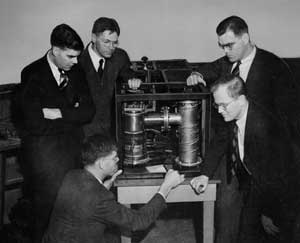Meeting Reports from Forum-Sponsored Sessions: 2009 March Meeting
The Origins of Silicon Valley
By Gloria B. Lubkin, Forum Chair
On Monday afternoon, March 16, the Forum sponsored an invited session on "The Origins of Silicon Valley." The three speakers traced its origins back to 1910, covering the major scientific, technological, educational, military, and business developments that culminated half a century later in the production of the first commercial silicon integrated circuits. At the session's end they participated in a panel discussion chaired by Gloria Lubkin, fielding questions from an audience of nearly 200.
Stewart Gillmor of Wesleyan University covered the prehistory of the valley, from 1910 to 1965. By the time the term "Silicon Valley" was coined in 1971, he said, the San Francisco Bay Area had already become a thriving center of instrumentation, electronics, avionics, and particle physics. He attributed this rise to its location with respect to continental and Pacific transportation and communication needs; the growth of West Coast population, markets and universities; the recruitment of talented people from the East; and innovative industrial and business methods.

Credit: Stanford News Service
(l - r) Sigurd Varian, Russell Varian, David Webster, John Woodyard, and William Hansen inspecting the first klystron.
David Leeson (Stanford University) talked about "W. W. Hansen, Microwave Physics, and Silicon Valley." Known as the father of microwave electronics, Hansen and his collaborators laid the foundations of Silicon Valley's postwar microwave phase, when numerous companies flourished around Stanford, Leeson said. These firms furthered the regional entrepreneurial culture and prepared the ground for the semiconductor and computer developments that followed. After getting his Ph.D. from Stanford in 1932, Hansen spent two years as an MIT postdoc and then returned to Stanford "as a whiz in electromagnetism." He invented and patented the cavity resonator. From 1935 to 1937, he applied the cavity resonator to his concept of the radio-frequency linear accelerator and, with the Varian brothers, to the klystron invention. The Varians first set up a lab in their house; then in May 1937 they came to Stanford and asked Hansen to help them. After the invention was demonstrated in August 1937, Sperry Gyroscope licensed the rights to use the klystron for radar. It made airborne radar possible, according to Leeson, and contributed to the Allied victory in World War II.
During the War, Hansen's group relocated to Sperry's Long Island plant. He also gave a series of lectures to the scientists and engineers recruited to work on radar at the MIT Radiation Lab. In Leeson's opinion, the notes were never published because of rivalry between MIT and Stanford, Hansen's failing health, and his postwar work. But they had a major impact on subsequent works, including the Rad Lab series on radar.
After the War, Hansen founded Stanford's Microwave Lab to develop high-power klystrons and linear accelerators. He collaborated with Felix Bloch in the discovery of nuclear magnetic resonance, but died in 1949, at age 39, of berylliosis. To celebrate the centenary of Hansen's birth, Leeson will publish Hansen's lecture notes with a biography of him. Leeson was a founder of a Silicon Valley company, California Microwaves; after 25 years as its CEO, he retired to become a Stanford professor.
"From Bell Labs to Silicon Valley: A Saga of Technology Transfer, 1954-1961" was the title of the talk by Michael Riordan (Stanford and UC Santa Cruz), the John Bardeen Lecturer. "Although Bell Labs invented the transistor and developed most of the underlying semiconductor technology," Riordan said, the integrated circuit emerged elsewhere—at Texas Instruments and Fairchild Semiconductor.In 1947 the point-contact transistor was invented by Bardeen and Walter Brattain. A month later William Shockley conceived the junction transistor, which used three layers of either silicon or germanium. The first silicon transistors were fabricated in 1954, by Morris Tanenbaum at Bell Labs and by Gordon Teal, who had left Bell Labs for Texas Instruments. The following year Tanenbaum and his technician made the first diffused-base transistor in silicon.
When Shockley learned about the diffused-base silicon transistor, he almost immediately recognized its commercial potential. In 1955, with the backing of Arnold Beckman (founder of Beckman Instruments), Shockley Semiconductor Laboratory opened for business in Mountain View, California. Shockley hired a promising team of engineers and scientists to develop and manufacture transistors and related semiconductor devices. Because Shockley had licensed rights to the transistor patents from AT&T, he wound up getting a lot of handholding through his personal contacts at Bell Labs. But two years later eight of the original hires, including Gordon Moore and Robert Noyce, resigned together to start Fairchild Semiconductor in 1957. That event, observed Riordan, "marked the birth of Silicon Valley, both technologically and culturally." In 1961 the company marketed the first commercial silicon integrated circuits, the Micrologic series. "Seven years later Noyce and Moore left to form Intel," he said, "and the rest is history."
Note Added: This article represents the views of the author, which are not necessarily those of the FHP or APS.
